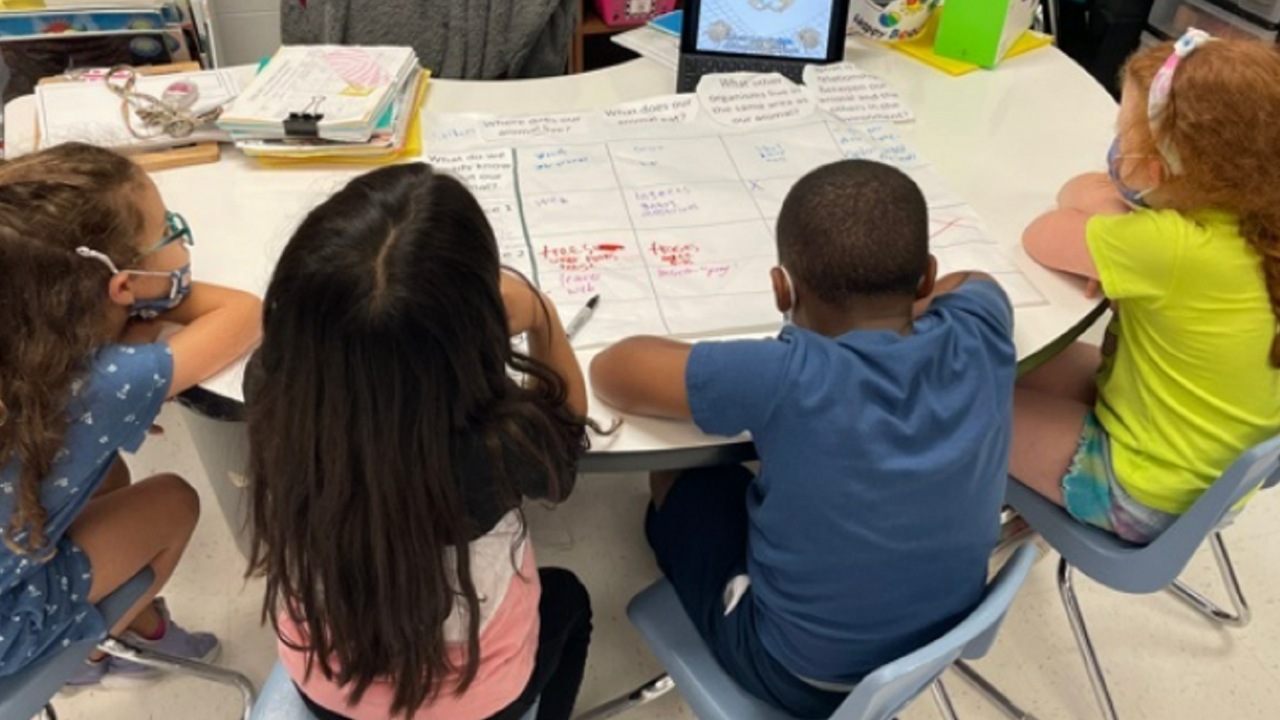Day 13: Preparing the Science Presentation (Part 1)

-
Culminating Project
OVERVIEW
Today, learners are introduced to the culminating activity for the unit.
SUMMARY OF THE WORK THUS FAR
Throughout the unit, the children have worked in science Inquiry Circles to research various outdoor organisms, and they have developed new knowledge about the environments in which these organisms live. They have also conducted science investigations to determine what pill bugs eat. Now, teams prepare for a “science conference” in which they will share what they have learned about the organisms they have researched and the science investigation they have conducted. This will serve as the culminating activity for the unit.
Learners will spend about 2 days working on their projects and making connections between their text-based inquiries and their Science Investigations. We suggest about 90 minutes for each day, but you can decide how much time to allow based on your schedule and learners’ need. After the 2 days of preparation, you will need to plan 1 day for presentations of the team projects.
BACKGROUND INFORMATION FOR THE TEACHER
Scientists often present their expertise in the topic they’ve been studying at a science conference with other scientists so that new information can be shared across the scientific community. Conferences give scientists the opportunity to summarize their findings in an oral presentation before a live audience.
There are several things that the scientific community expects, including the use of scientific language in both the written and spoken presentation. These are things to note and talk about with children as they prepare for the culminating activity.
MATERIALS
Each team needs:
- “Pill Bug Investigation” journals
- team Inquiry Chart
- team CER charts
- materials for making a poster or planning a science talk, including traditional materials (e.g., paper and writing/drawing materials; poster board; markers)
- labeled photos of the food the teams put into their pill bug mini-habitat
- pill bug mini-habitat (optional for use in the presentation)
- “Culminating Project Organizer” document (optional)
Teacher needs:
- copy of the “G1 Culminating Project Choices” document
SETUP
- Designate a central location where children can access all of the materials needed for their culminating projects.
- If learners will be using the “Culminating Project Organizer” document, make copies (1 per learner).
PROCEDURE
We have provided two choices for a culminating project: a poster or an oral science talk. Details for each can be found in the “G1 Culminating Project Choices” document. The teacher may choose to assign the same project to all teams or to allow each team to choose from the two. The teacher will know best which option will work for the class.
- Once a project has been chosen, the teacher will need to instruct learners on the requirements for successfully completing it; these are listed in the “G1 Culminating Project Choices” document. Read the requirements out loud to the class and ask for any questions or give clarification as needed.
-
- Remember that the requirements can be modified to best suit the needs of your class. (Ask Equipment Directors to hand out the “Culminating Project Organizer” to team members if learners will be using this.)
- Tell learners that they have some decisions to make as they start their projects:
-
- What information do they most want to share with others? Remind them of what they have learned about how organisms live with and are dependent on each other in different ecosystems. Cite an example of “interdependence” from their research.
- How can they use the information from their Inquiry Charts, their “Pill Bug Investigation” journals, and their team CER charts?
- Will they use images and drawings? Remind teams that they also have the pictures you took of the food in their habitats and the drawings they made in their journals.
- Their audience (fellow scientists) will expect them to use scientific language. What technical words and phrases might they need to include in their projects?
- Who is going to do what for the project? They should decide who will be responsible for each part of the project (writing, drawing, speaking, etc.) Remind them that they are a team and should work together to create their project.
- Encourage learners to think in terms of claims as they prepare their projects:
-
- What claim(s) have they made based on their observations and investigations?
- What evidence do they have to support the claim(s)?
- How will they present their evidence?
- Tell learners that they will have 2 days, including today, to work on their projects.
- Let them know that their culminating projects will be presented at their own science conference in the classroom before a live audience and that they should be prepared to answer questions from audience members. (The teacher may choose to invite parents or colleagues to attend!)
- After the project has been explained and questions have been answered, children will use the remaining time to work on their projects. The teacher should move around between teams, offering guidance as needed and asking questions about their work.


